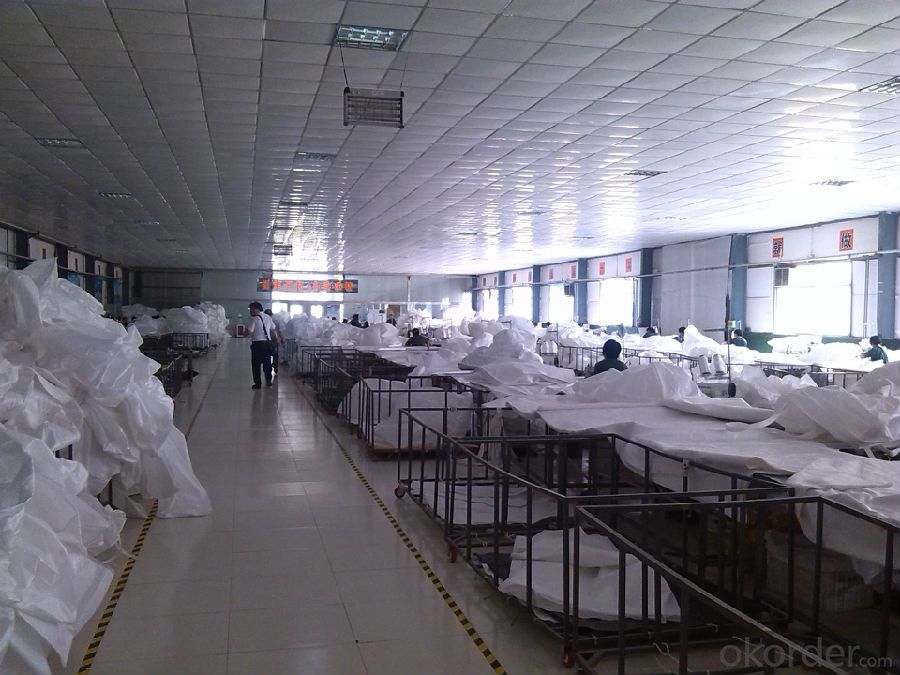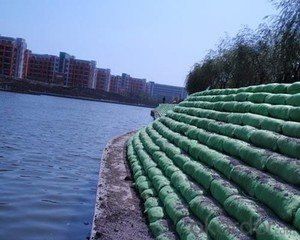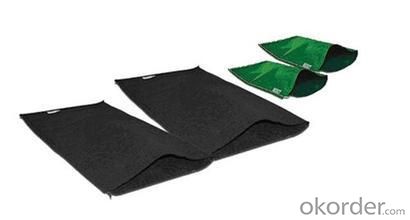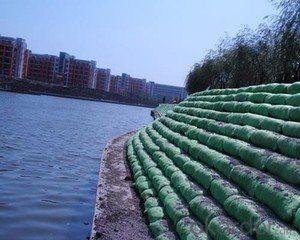PET/PP Nonwoven Geo Bag with CE Certification
- Loading Port:
- Qingdao
- Payment Terms:
- TT OR LC
- Min Order Qty:
- 30000 pc
- Supply Capability:
- 500000 pc/month
OKorder Service Pledge
OKorder Financial Service
You Might Also Like
Description Of PET/PP Nonwoven Geo Bag
Geo bag
Bags processed from non-woven polypropylene (PP) or polyester (PET) as a raw material made of double-sided ironing acupuncture.
Take full account of the many disciplines of materials, mechanics, hydraulics, biology, botany and other requirements under the premise, the thickness of the UV resistance of ecological bags, per unit mass, physical and mechanical properties, shape, fiber type, the way by force, direction, geometric dimensions and Permeability and meet the equivalent aperture and other indicators of plant growth rigorous screening, anti-UV (UV), anti-aging, non-toxic, non-combustion, the gap does not extend the characteristics of truly zero pollution. Used primarily for the construction of flexible ecological slope. The greening of the eco-bag slope protection, barren hills, mine repair, one of the highway slope greening, riverbank slope protection, river regulation, construction methods.
Main Features of PET/PP Nonwoven Geo Bag
1. Eco Bags: shopping bags, suit bags, promotional bags, gift bags, tote bag, etc.
2. Home Textiles: table cloth, disposable cloth, furniture upholstery, pillow & sofa cover, spring pocket, mattress and quilt, dust cover, storage box, wardrobe, one-time hotel slippers, gift packing, wall paper, etc.
3.Interlining: shoes, garments, suitcase, etc.
4. Medical/ Surgical: surgery cloth, operation gown and cap, mask, shoe cover,etc
5. Agriculture: UV treated products used in agriculture, plant bag, keep fruit warm cover, crop cover/mulch, agricultural antifreeze tents, etc.
6. Car/ Auto cover and upholstery
Specifications of PET/PP Nonwoven Geo Bag
| No. | Specification(g/m2) | 100 | 150 | 200 | 250 | 300 | 350 | 400 | 450 | 500 | 600 | 700 | 800 | 1000 | Remark |
| 1 | Weight deviation, % | -8 | -8 | -8 | -8 | -7 | -7 | -7 | -7 | -6 | -6 | -6 | -6 | -6 | |
| 2 | Thickness, mm≥ | 0.9 | 1.3 | 1.7 | 2.1 | 2.4 | 2.7 | 3 | 3.3 | 3.6 | 4.1 | 4.5 | 5 | 5.8 | |
| 3 | Width deviation,% | -0.5 | |||||||||||||
| 4 | Breaking strength, KN/m ≥ | 2.5 | 4.5 | 6.5 | 8 | 9.5 | 11 | 12.5 | 14 | 16 | 19 | 22 | 25 | 31 | MD and CD |
| 5 | Breaking elongation,% | 25~100 | |||||||||||||
| 6 | CBR bursting strength, KN≥ | 0.3 | 0.6 | 0.9 | 1.2 | 1.5 | 1.8 | 2.1 | 2.4 | 2.7 | 3.2 | 3.7 | 4 | 5 | |
| 7 | Sieve Size O90 mm | 0.07~0.2 | |||||||||||||
| 8 | Vertical permeability | Kx(10-1~10-3 ) | K=1.0 ~9.9 | ||||||||||||
| coefficient, cm/s | |||||||||||||||
| 9 | Tear strength, KN≥ | 0.08 | 0.12 | 0.16 | 0.2 | 0.24 | 0.28 | 0.33 | 0.38 | 0.42 | 0.46 | 0.53 | 0.6 | 0.75 | MD and CD |
PET/PP Nonwoven Geo Bag Images




FAQ
1. Do you supply free samples for customers?
Yes,we will supply free samples for you.Please send your address for us.
2. How Many years experience do you have?
We have been exported to more than 20 countries in the past 15 years.
3. How long do we usually reply your request?
We always reply our customer within 24 hours.
- Q:What is the use of the black network when the shop is paved?
- Black net Is a grid geotextile bar. Geotextile isolation: the use of geotextiles with different physical properties (particle size, distribution, consistency and density, etc.) of building materials (such as soil and sand, sand and gravel, soil and concrete, etc.) to isolate. So that two or more materials are not lost, not mixed, to maintain the overall structure and function of the material, so that the structure of the load capacity to strengthen. 2, filament geotextile filter: When the water from the fine soil into the coarse soil layer, the use of acupuncture geotextile good permeability and water permeability, so that water through. And effectively cut off the soil particles, sand, small stone, etc., in order to maintain the stability of soil and water engineering. 3, filament geotextile drainage: geotextile is a good water guide material, it can form a drainage channel in the soil structure, the soil structure of the excess liquid and gas excluded. 4, filament geotextile reinforcement: the use of geotextiles to enhance the soil tensile strength and resistance to deformation, enhance the stability of the building structure to improve soil quality. 5, filament geotextile protection: the effective concentration of concentrated diffusion, transmission or decomposition, to prevent the soil by external force and damage. 6, filament geotextile closure: geotextile and other materials (asphalt, plastic film) with the formation of impermeable in the soil layer. (Mainly for road resurfacing, repair, etc.).
- Q:How do geotextiles affect soil temperature?
- Geotextiles can have an impact on soil temperature by acting as an insulating layer. They can help regulate soil temperature by reducing heat transfer between the soil and the atmosphere. This insulation effect can prevent soil from overheating in hot climates or help retain warmth in colder regions. Additionally, geotextiles can also minimize temperature fluctuations in the soil, providing a more stable environment for plant growth.
- Q:How do geotextiles help with soil reinforcement in geogrid applications?
- Geotextiles help with soil reinforcement in geogrid applications by acting as a separation layer between the soil and the geogrid. They prevent the intermixing of different soil layers, which helps maintain the integrity of the geogrid by preventing soil displacement. Additionally, geotextiles enhance the overall performance of the geogrid by distributing the loads more evenly across the soil surface, reducing the potential for localized stress concentrations.
- Q:What are the different geotextile permeability testing methods?
- Some different geotextile permeability testing methods include the constant head method, falling head method, and the flexible wall permeameter method. The constant head method involves applying a constant water head to the geotextile specimen and measuring the flow rate. The falling head method involves measuring the time it takes for the water level to fall a known distance in a permeameter connected to the geotextile specimen. The flexible wall permeameter method measures the flow rate through a specimen confined between two flexible walls. These testing methods help determine the permeability and hydraulic properties of geotextile materials.
- Q:Polyester non-woven and geotextile is not the same, what is the difference?
- In simple terms, the number of raw materials is different.
- Q:How do geotextiles contribute to soil stabilization in mining areas?
- Geotextiles contribute to soil stabilization in mining areas by providing reinforcement and preventing erosion. These synthetic materials are placed within the soil to enhance its strength and stability, reducing the risk of landslides and soil disturbances. Geotextiles also act as a barrier, preventing the migration of fine particles, thereby improving soil filtration and preventing contamination of nearby water bodies.
- Q:How do geotextiles help in stabilizing slopes for pipeline construction?
- Geotextiles help in stabilizing slopes for pipeline construction by providing reinforcement and erosion control. They are placed along the slope to prevent soil erosion and promote stability. The geotextiles act as a barrier, preventing the movement of soil particles and reducing the risk of slope failure. Additionally, they enhance the soil's strength and increase its resistance to erosion caused by water flow. Overall, geotextiles play a crucial role in maintaining the stability of slopes during pipeline construction.
- Q:Can geotextiles be used in green infrastructure projects?
- Yes, geotextiles can be used in green infrastructure projects. They are often employed to promote healthier soil conditions, prevent erosion, manage stormwater runoff, and enhance the overall sustainability of green infrastructure systems. Geotextiles can be utilized in various applications such as erosion control blankets, sediment filters, retaining walls, and vegetated roofs, making them an essential component in the implementation of green infrastructure practices.
- Q:The outside of the blind tube is not to be with the geotextile 1 effect will be better?
- Plastic blind ditch is a new geosynthetics, is composed of plastic core wrapped outside the filter composition. At present the plastic core has several different cross-sectional shape rectangular, hollow rectangular, circular and hollow circular species structure of the plastic blind ditch products. Pass the water to see the original tie & gt; & gt;
- Q:What are the key properties of geotextiles?
- Geotextiles are permeable fabrics made from synthetic materials, such as polyester or polypropylene, and are primarily used in civil engineering and construction projects. The key properties of geotextiles include high tensile strength, excellent filtration capabilities, good durability, and resistance to biological degradation. They also provide effective drainage, soil stabilization, and erosion control, making them a versatile solution for various applications in geotechnical engineering.
1. Manufacturer Overview |
|
|---|---|
| Location | |
| Year Established | |
| Annual Output Value | |
| Main Markets | |
| Company Certifications | |
2. Manufacturer Certificates |
|
|---|---|
| a) Certification Name | |
| Range | |
| Reference | |
| Validity Period | |
3. Manufacturer Capability |
|
|---|---|
| a)Trade Capacity | |
| Nearest Port | |
| Export Percentage | |
| No.of Employees in Trade Department | |
| Language Spoken: | |
| b)Factory Information | |
| Factory Size: | |
| No. of Production Lines | |
| Contract Manufacturing | |
| Product Price Range | |
Send your message to us
PET/PP Nonwoven Geo Bag with CE Certification
- Loading Port:
- Qingdao
- Payment Terms:
- TT OR LC
- Min Order Qty:
- 30000 pc
- Supply Capability:
- 500000 pc/month
OKorder Service Pledge
OKorder Financial Service
Similar products
New products
Hot products
Related keywords

































